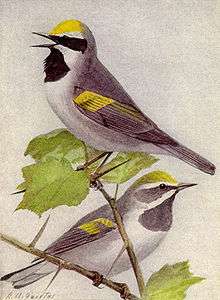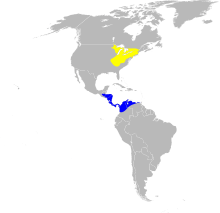Golden-winged warbler
| Golden-winged warbler | |
|---|---|
 | |
| Male and Female birds | |
| Scientific classification | |
| Kingdom: | Animalia |
| Phylum: | Chordata |
| Class: | Aves |
| Order: | Passeriformes |
| Family: | Parulidae |
| Genus: | Vermivora |
| Species: | V. chrysoptera |
| Binomial name | |
| Vermivora chrysoptera (Linnaeus, 1766) | |
 | |
| Range of V. chrysoptera Breeding range Wintering range | |
| Synonyms | |
|
Helmintophila chrysoptera: Ridgway 1882 | |
The golden-winged warbler (Vermivora chrysoptera) is a New World warbler. It breeds in southeastern and south-central Canada and the Appalachian Mountains northeastern to north-central United States. The majority (~70%) of the global population breeds in Wisconsin, Minnesota, and Manitoba. Golden-winged warbler populations are slowly expanding northwards, but are generally declining across its range, most likely as a result of habitat loss and competition/interbreeding with the very closely related blue-winged warbler, Vermivora cyanoptera.
Etymology
The genus name Vermivora is from Latin vermis "worm", and vorare, "to devour", and the specific chrysoptera is from Ancient Greek khrusos, "gold", and pteron, "wing".[2]
Description

This is a small warbler, measuring 11.6 cm (4.6 in) long and weighing 8–10 g (0.28–0.35 oz). The male has black throat (suggestive of the throat patch of a chickadee), black ear patch bordered in white, yellow crown and wing patch. Females feature a similar coloration pattern, but the black is replaced with light grey. In both sexes, extensive white on the tail is conspicuous from below. Underparts are grayish white and the bill is long and slender. Unlike most warblers, juveniles can be reliably sexed (using throat patch color) approximately 15 days after fledging. Pure breed golden-winged warblers are almost unmistakable if seen well.
Life history
Golden-winged warblers are migratory, breeding in eastern North America and wintering in southern Central America and the neighboring regions in Colombia, Venezuela, and Ecuador. This is a very rare vagrant to western Europe, with a single record of a bird wintering in a supermarket car park in Maidstone, Kent in 1989 and another from Corvo, Azores, in October 2012.
Golden-winged warblers breed in open scrubby areas, wetlands, and mature forest adjacent to those habitats. They lay 3–6 eggs (often 5) in a highly concealed cup nest on the ground or low in a bush.
These birds feed on insects, and spiders, most often leaf-roller caterpillars. Golden-winged warblers have strong gaping (opening) musculature for their bill, allowing them to uncover hidden caterpillars.
The song is highly variable, but is most often heard as a trilled bzzzzzzz buzz buzz buzz. The call is a buzzy chip or zip.
Golden-winged warblers are the first bird to be observed migrating during the breeding season to avoid tornadic storms. Individuals left prior to the arrival of the storm, perhaps after detecting it due to infrasound.[3]
Hybridization
This species forms two distinctive hybrids with blue-winged warbler where their ranges overlap in the Great Lakes and New England area. The more common, genetically dominant Brewster's warbler is gray above and whitish (male) or yellow (female) below. It has a black eyestripe and two white wingbars.
The rarer recessive Lawrence's warbler has a male plumage which is green and yellow above and yellow below, with white wing bars and the same face pattern as male Golden-winged. The female is gray above and whitish below with two yellow wing bars and the same face pattern as female Golden-winged. Both Brewster's and Lawrence's warblers can vary considerably in their physical features and can potentially sing songs of either the blue-winged or the golden-winged warblers.
Genetic introgression occurs across their range, producing cryptic hybrids (morphologically pure individuals with small amounts of blue-winged warbler DNA). These hybrids may be present in low numbers even on the edges of golden-winged warbler range, far from any populations of blue-winged warblers.
References
- ↑ BirdLife International (2012). "Vermivora chrysoptera". IUCN Red List of Threatened Species. Version 2013.2. International Union for Conservation of Nature. Retrieved 26 November 2013.
- ↑ Jobling, James A. (2010). The Helm Dictionary of Scientific Bird Names. London, United Kingdom: Christopher Helm. pp. 105, 400. ISBN 978-1-4081-2501-4.
- ↑ Henry M. Streby et al. (2015) "Tornadic Storm Avoidance Behavior in Breeding Songbirds"Current Biology, 25(1), pp. 98 – 102.
External links
| Wikimedia Commons has media related to Golden-winged warbler. |
| Wikispecies has information related to: Vermivora chrysoptera |
- Golden-winged warbler - Vermivora chrysoptera - USGS Patuxent Bird Identification InfoCenter
- Golden-winged warbler species account - Cornell Lab of Ornithology
- "Golden-winged warbler media". Internet Bird Collection.
- Golden-winged warbler photo gallery at VIREO (Drexel University)
